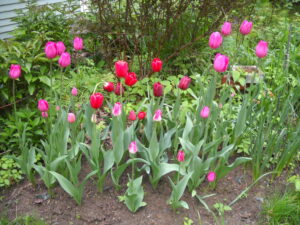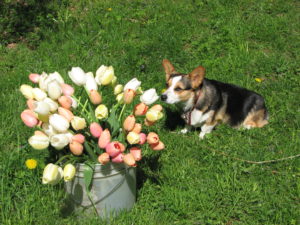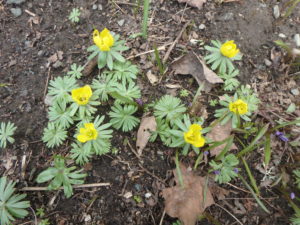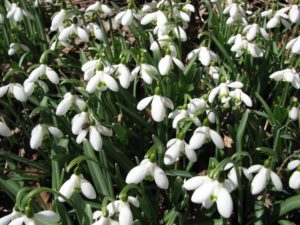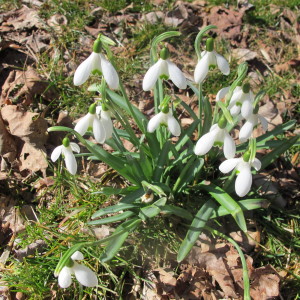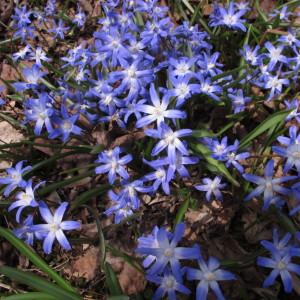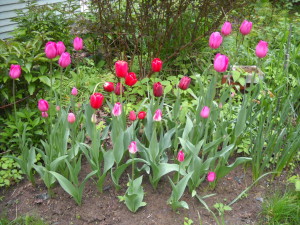It’s Time for Fall Plantings
Spring is all about planting, but many gardeners overlook fall planting. Now is the time to plant garlic and spring-blooming flowers planted as bulbs. For me, fall planting is a joy: the thought of bulbs nestled into the ground just awaiting spring fills me with hope. And if you pick a good spot and plant them well, you are sure to succeed.

I will plant about 10 daffodils between these hostas that will hide the leaves of the daffies after blooming
This is also the time to plant daffodils, tulips and all the small bulbs that bloom early. If you have a fenced yard, that will keep the deer from eating tulip blossoms when in bud – a real treat for them. If you have a problem with deer, you might want to avoid tulips, or plant them in pots for forcing.
Next I add some good compost and either “Bulb Booster” or slow-release organic fertilizer, and work it into the soil with my CobraHead weeder, a single-tined hand tool. Then I arrange the bulbs in the loosened soil in the bottom of the hole, with fat bottom down, and the pointy head up. I mix some compost into the soil I removed, and carefully fill the hole.
The Spring Bulb Flowers
Now is the time to decide where you should plant bulbs next fall. Here’s what I do: I wander around my property each year in the spring to see what spots are bare of bulb flowers. I bring along those white plastic markers used for labeling, and write “add crocus here”, for example. Then in the fall, when it’s time to plant more bulbs I don’t have to rely on my memory to know what to plant, and where.
When planting bulbs, I label what I‘ve planted. That way I’ll see what has performed well, and remember to buy more of the same. For example, I’m always eager to get color in the garden at the same time that the white snowdrops bloom. Two purple-blue bulbs bloom about the same time: Glory-of-the-snow is one plant that overlaps with snowdrops, but is a bit later, as is scilla.
This spring I saw a crocus that was labeled ‘Blue Pearl’, that is blooming with my snowdrops – and before those other two. So I’ll buy 100 of those for fall planting. I bought them at Brent and Becky’s Bulbs– I know because they include tags with each bag of bulbs. And I can order them now for delivery then.
This year I am delighted to see that the winter aconite that produced seed 2 years ago is going to bloom. Last year I recognized the leaves, but it did not produce blossoms. It is a very early bright yellow flower that has one-inch wide, six-petaled flowers. I’ve grown it before but lost it to cold or rodents or poor drainage, and re-planted in other spots. This new patch will give me 50 or so “free” flowers.
I tend to blame bulb failure on drainage problems, not rodents. I mix in lots of compost at planting time and favor hillsides, which helps with drainage. Wet soil is hard on bulbs. Our cats tend to keep rodents away. South facing hillsides are great for early bulbs as the snow melts off weeks earlier than north-facing plots, and drain well.
A bulb plant that I’ve considered fussy is a low-growing iris, Iris reticulata. It is just a few inches tall and has medium-sized blue, purple or (sometimes) yellow flowers. Doing some research I found out why I thought they are fussy: after they bloom, the bulbs divide, producing several little bulblets. These won’t bloom for a few years. So I need to plant some every year until I have a mature colony of them. I also read that they like soil that dries out well in summer, such as in a rock garden or sandy hillside.
My lawn is full of snowdrops that have planted themselves. I assume that they produce seeds that wash into the lawn during summer rains. The bulk of my snowdrops are planted on a hillside above the lawn. But you can plant early spring bulbs in the lawn, too. Just don’t plant daffodils or anything with large leaves because you won’t be able to mow the lawn where they are growing until the leaves yellow and dry off – around July 4th. Bulb plants need to re-charge their batteries, if you will, by getting sunshine and storing energy.
Little bulbs like snowdrops, crocus and grape hyacinths have short leaves that disappear early and won’t disrupt your early mowing. You can always set the lawn mower blades high to protect the leaves if they are still green when you need to cut the lawn.
Grape hyacinths (Muscari spp.) are great little flowers that come in many different shades of blue and purple. I’ve planted many dozens in my day, but find they tend to lose vigor and disappear with time. So I plant them again. Whenever I see grape hyacinths for sale in pots at the grocery store, I buy them. I enjoy them immensely in the house. Later, when the soil is thawed, I plant them outside. I keep the pot in a cool space indoors, as if they get too warm, they flop over.
Tulips I treat like annuals. Why? They do well the first year, but quickly go downhill or disappear in subsequent years no matter what I do. I plant 100 most years in a bed that I reserve for them. Later I plant zinnias in the same bed, so I don’t bother to coddle them. My corgi, Daphne, keeps the deer away.
Daffodils are slightly poisonous to deer and rodents, so they aren’t eaten – and can bloom for years. You can plant them in open woodlands and they will do fine. By the way, if you forced paperwhites this winter, don’t bother planting them outdoors – they’re not hardy here.
I’ve been paying attention to bulb flowers at least since I was 9 years old. I recently found entries in my diary that tell me so. My entry for March 7, 1956, in its entirety was this: “Spring is getting here at last the snow drops are in bud + will bloom in a few days.” Then on April 5 I wrote,” Today our first crocus was in bloom it is very pretty.” As a guy who makes his living writing, I no longer keep a daily journal. I tend to document my life now with a digital camera – and this column. Thanks for keeping me writing!
Henry lives and gardens in Cornish Flat, NH. You may reach him at henry.homeyer@comcast.net. He is the author of 4 gardening books.
Planting Bulbs
For the past 3 decades or more I‘ve planted the bulbs of spring-blooming plants every fall. Some years it was just a couple of dozen, other years more than 100. October is a good time to plant them, though one year I was traveling and didn’t plant my bulbs until November. I had to shovel snow off the ground to plant bulbs that year.
I plant bulbs because it gives me something to look forward to during the depths of winter. I dream of clouds of purple scilla and white snowdrops, hillsides awash with golden daffodils, vases of tulips on every flat surface of the house. For the price of dinner for two at a moderate restaurant, you can buy 100 bulbs or more – and now is the time to do so.
I love snow drops (Galanthus nivalis). Granted, they’re small and their blossoms hang down so they’re hard to see their faces well, but they’re the first to bloom, often coming up through frozen soil in early March. I transplanted fifty or a hundred from my childhood home in Connecticut 35 years ago, and by now I have uncountable numbers. They sneak into my lawn, popping up far from where I put them. I don’t know how they move around – perhaps by seed, or perhaps with the help of those otherwise pesky rodents, the squirrels.
Other early bloomers are scilla (Scilla siberica) and glory-of-the-snow (Chionodaxa spp.), both blue to purple (glory-of-the snow also comes in pink and white). Like snowdrops, they’re small – so they need to be planted in groups of 50 or more to really look good.
Crocuses also can bloom early, though I’ve never had any as early as my snowdrops. There are at least 80 species of crocus and many hundreds of colors, but most garden centers and grocery stores just offer a couple of species and three colors – large purple, white or yellow. For that reason I study the bulb catalogs to explore other possibilities.
The bulb company McClure and Zimmerman has an excellent array of crocus, but I find their website awkward, so it is probably worth calling for a print catalog (800-546-4053). Brent and Becky’s bulbs is a family run business that is also excellent (www.brentandbeckysbulbs.com or 804-693-3966). You may be surprised to see that crocus bulbs can cost over a dollar each, but the rarer varieties are pricey.
Daffodils are wonderful, in part, because animals don’t eat them, not rodents, not deer. There are hundreds of kinds of daffodils in 13 major categories. Some bloom early, some late. Some produce one flower per stem, others several. I continue to explore the daffodils each year by buying some new ones- and you should, too.
If you grow hostas, you know that their leaves don’t get very big until June or July. I like to plant clumps of daffodils between clumps of hosta so that their leaves will cover the foliage of the daffodils after they bloom.
In recent years I have been buying 100 tulips and planting them in one bed. I like them as cut flowers – and they make terrific gifts. I like having enough to pick dozens at a time, and having them all come into bloom at once.
Most tulips, for me, tend to run out of energy and get fewer in number as the years pass, so now I consider them annuals. I dig a hole about 4-5 feet long and 2 feet across and plant all 100 in one place. Then, once they are done, I cut off the foliage and plant annual cut flowers like zinnias for summer enjoyment. Wasteful? I suppose, but life is short, and I love them so.
I’ve found that my CobraHead weeder (www.CobraHead.com or 866-962-6272) works well for planting individual small bulbs like snowdrops or crocus in the lawn. I just push it into the soil the appropriate depth, pull back to create a small slice in the soil, take out the tool and drop in a bulb. The slice in the lawn closes up easily with a push of my hand.
My last bits of advice on planting bulbs: add some slow-release organic fertilizer (or bulb booster) at planting time, and mix plenty of compost into the soil. Bulbs need good drainage to thrive, and compost helps with that. If you are worried about rodents, you can sprinkle them with cayenne pepper, though its effect only lasts for a year.
Lastly, buy plenty of bulbs. Come spring, you’ll revel in their beauty and enjoy them much more than that ephemeral dinner for two you might skip now in order to afford their cost.
Read Henry’s blog about how to save your dahlia tubers for next year at https://dailyuv.com/news/




